Unit 37 Consumer Behaviour and Insight: Apple Inc. Report Analysis
VerifiedAdded on 2022/11/25
|13
|4209
|248
Report
AI Summary
This report provides a comprehensive analysis of consumer behavior and decision-making processes, with a specific focus on Apple Inc. It explores the stages of consumer decision-making, including problem recognition, information search, evaluation of alternatives, purchase decision, and post-purchase evaluation, using the Apple Watch as a case study. The report also examines the differences in decision-making between Business-to-Consumer (B2C) and Business-to-Business (B2B) contexts, highlighting the influence of marketers in each stage. Furthermore, it evaluates different market research approaches and methods applicable to both B2B and B2C scenarios. The report concludes by assessing the impact of marketing mix elements and the importance of mapping the customer journey for marketers to effectively address customer needs and drive business success. The report also touches on the Pareto Principle and its relevance in the context of consumer behavior.
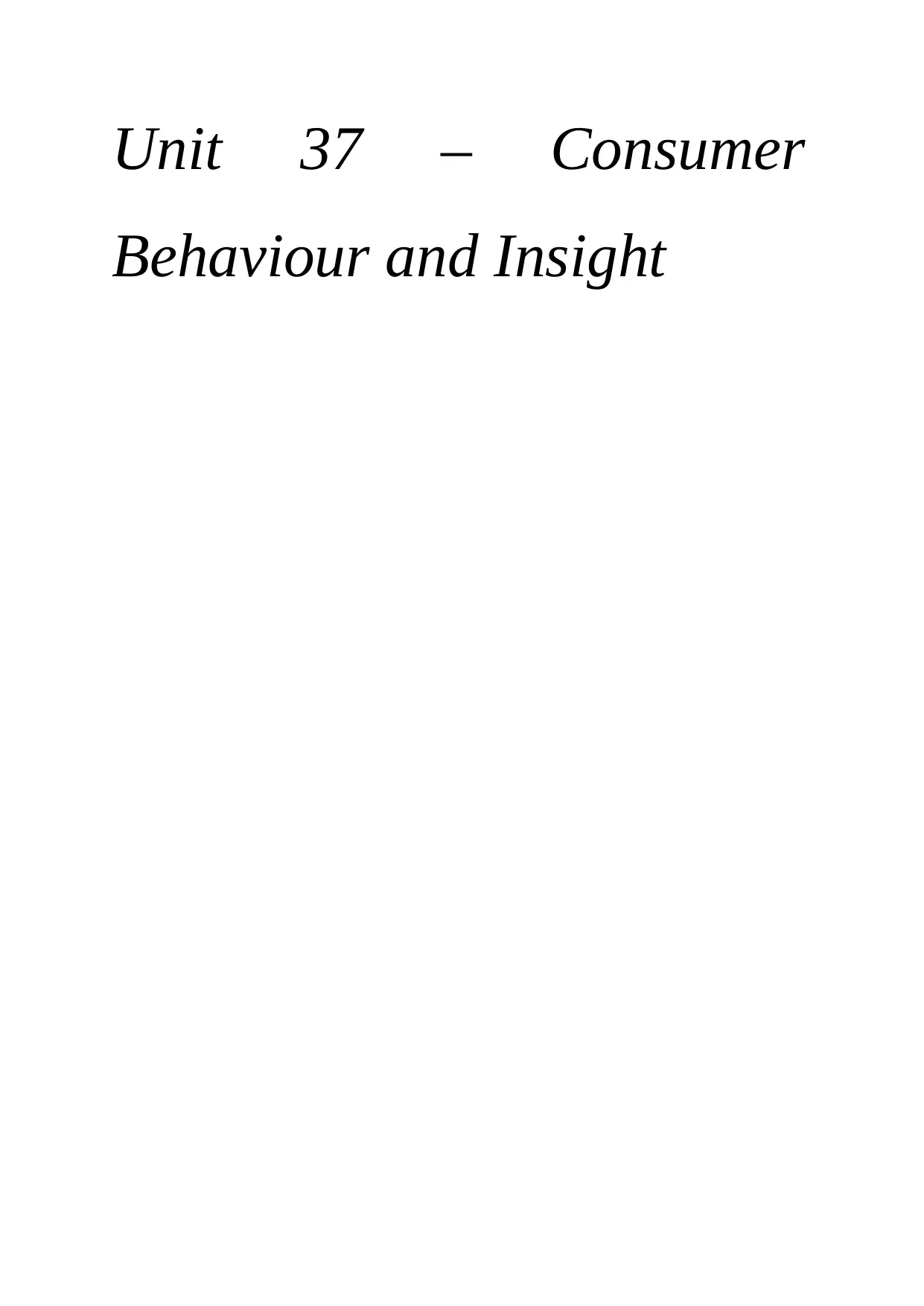
Unit 37 – Consumer
Behaviour and Insight
Behaviour and Insight
Paraphrase This Document
Need a fresh take? Get an instant paraphrase of this document with our AI Paraphraser
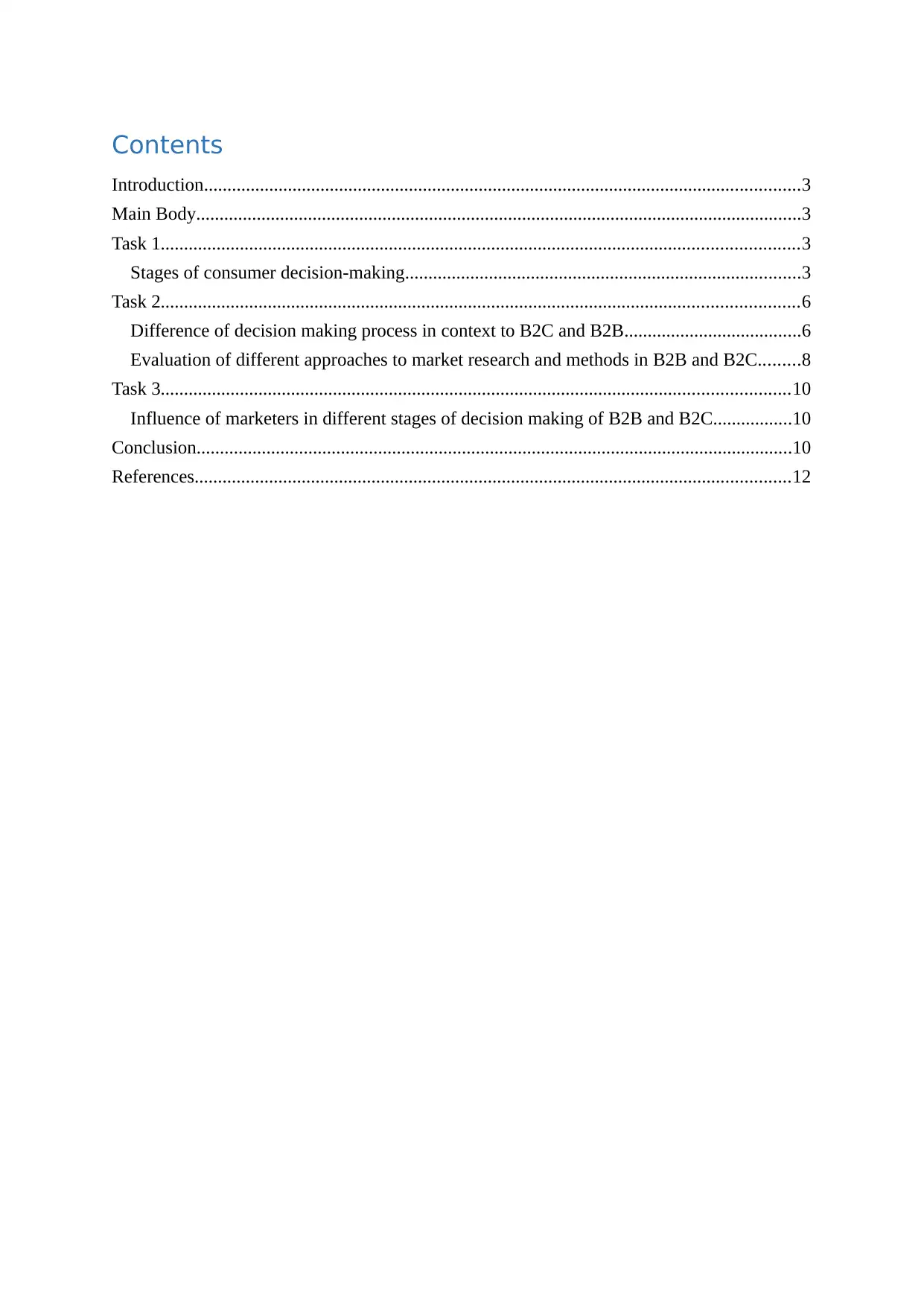
Contents
Introduction................................................................................................................................3
Main Body..................................................................................................................................3
Task 1.........................................................................................................................................3
Stages of consumer decision-making.....................................................................................3
Task 2.........................................................................................................................................6
Difference of decision making process in context to B2C and B2B......................................6
Evaluation of different approaches to market research and methods in B2B and B2C.........8
Task 3.......................................................................................................................................10
Influence of marketers in different stages of decision making of B2B and B2C.................10
Conclusion................................................................................................................................10
References................................................................................................................................12
Introduction................................................................................................................................3
Main Body..................................................................................................................................3
Task 1.........................................................................................................................................3
Stages of consumer decision-making.....................................................................................3
Task 2.........................................................................................................................................6
Difference of decision making process in context to B2C and B2B......................................6
Evaluation of different approaches to market research and methods in B2B and B2C.........8
Task 3.......................................................................................................................................10
Influence of marketers in different stages of decision making of B2B and B2C.................10
Conclusion................................................................................................................................10
References................................................................................................................................12
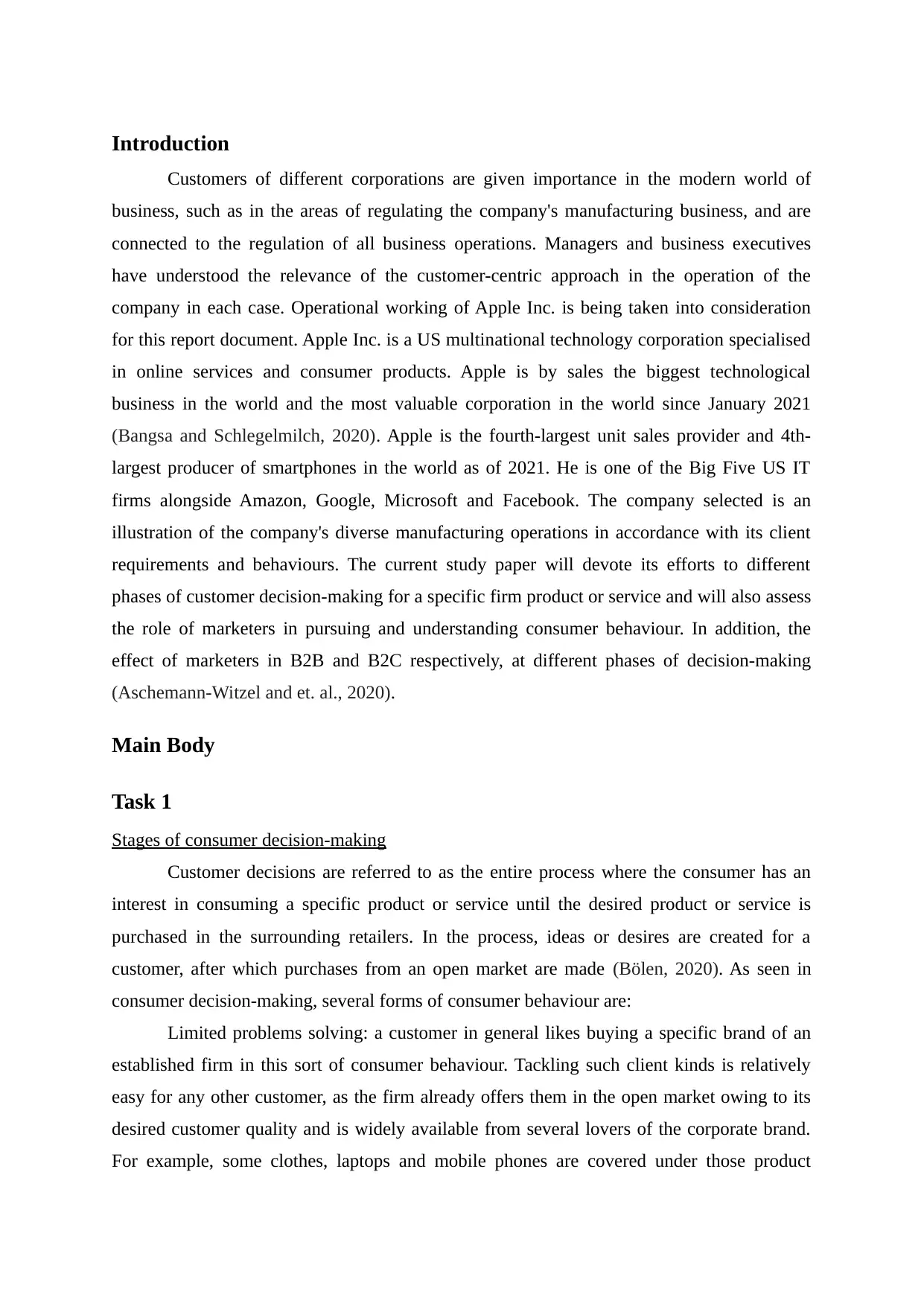
Introduction
Customers of different corporations are given importance in the modern world of
business, such as in the areas of regulating the company's manufacturing business, and are
connected to the regulation of all business operations. Managers and business executives
have understood the relevance of the customer-centric approach in the operation of the
company in each case. Operational working of Apple Inc. is being taken into consideration
for this report document. Apple Inc. is a US multinational technology corporation specialised
in online services and consumer products. Apple is by sales the biggest technological
business in the world and the most valuable corporation in the world since January 2021
(Bangsa and Schlegelmilch, 2020). Apple is the fourth-largest unit sales provider and 4th-
largest producer of smartphones in the world as of 2021. He is one of the Big Five US IT
firms alongside Amazon, Google, Microsoft and Facebook. The company selected is an
illustration of the company's diverse manufacturing operations in accordance with its client
requirements and behaviours. The current study paper will devote its efforts to different
phases of customer decision-making for a specific firm product or service and will also assess
the role of marketers in pursuing and understanding consumer behaviour. In addition, the
effect of marketers in B2B and B2C respectively, at different phases of decision-making
(Aschemann‐Witzel and et. al., 2020).
Main Body
Task 1
Stages of consumer decision-making
Customer decisions are referred to as the entire process where the consumer has an
interest in consuming a specific product or service until the desired product or service is
purchased in the surrounding retailers. In the process, ideas or desires are created for a
customer, after which purchases from an open market are made (Bölen, 2020). As seen in
consumer decision-making, several forms of consumer behaviour are:
Limited problems solving: a customer in general likes buying a specific brand of an
established firm in this sort of consumer behaviour. Tackling such client kinds is relatively
easy for any other customer, as the firm already offers them in the open market owing to its
desired customer quality and is widely available from several lovers of the corporate brand.
For example, some clothes, laptops and mobile phones are covered under those product
Customers of different corporations are given importance in the modern world of
business, such as in the areas of regulating the company's manufacturing business, and are
connected to the regulation of all business operations. Managers and business executives
have understood the relevance of the customer-centric approach in the operation of the
company in each case. Operational working of Apple Inc. is being taken into consideration
for this report document. Apple Inc. is a US multinational technology corporation specialised
in online services and consumer products. Apple is by sales the biggest technological
business in the world and the most valuable corporation in the world since January 2021
(Bangsa and Schlegelmilch, 2020). Apple is the fourth-largest unit sales provider and 4th-
largest producer of smartphones in the world as of 2021. He is one of the Big Five US IT
firms alongside Amazon, Google, Microsoft and Facebook. The company selected is an
illustration of the company's diverse manufacturing operations in accordance with its client
requirements and behaviours. The current study paper will devote its efforts to different
phases of customer decision-making for a specific firm product or service and will also assess
the role of marketers in pursuing and understanding consumer behaviour. In addition, the
effect of marketers in B2B and B2C respectively, at different phases of decision-making
(Aschemann‐Witzel and et. al., 2020).
Main Body
Task 1
Stages of consumer decision-making
Customer decisions are referred to as the entire process where the consumer has an
interest in consuming a specific product or service until the desired product or service is
purchased in the surrounding retailers. In the process, ideas or desires are created for a
customer, after which purchases from an open market are made (Bölen, 2020). As seen in
consumer decision-making, several forms of consumer behaviour are:
Limited problems solving: a customer in general likes buying a specific brand of an
established firm in this sort of consumer behaviour. Tackling such client kinds is relatively
easy for any other customer, as the firm already offers them in the open market owing to its
desired customer quality and is widely available from several lovers of the corporate brand.
For example, some clothes, laptops and mobile phones are covered under those product
⊘ This is a preview!⊘
Do you want full access?
Subscribe today to unlock all pages.

Trusted by 1+ million students worldwide
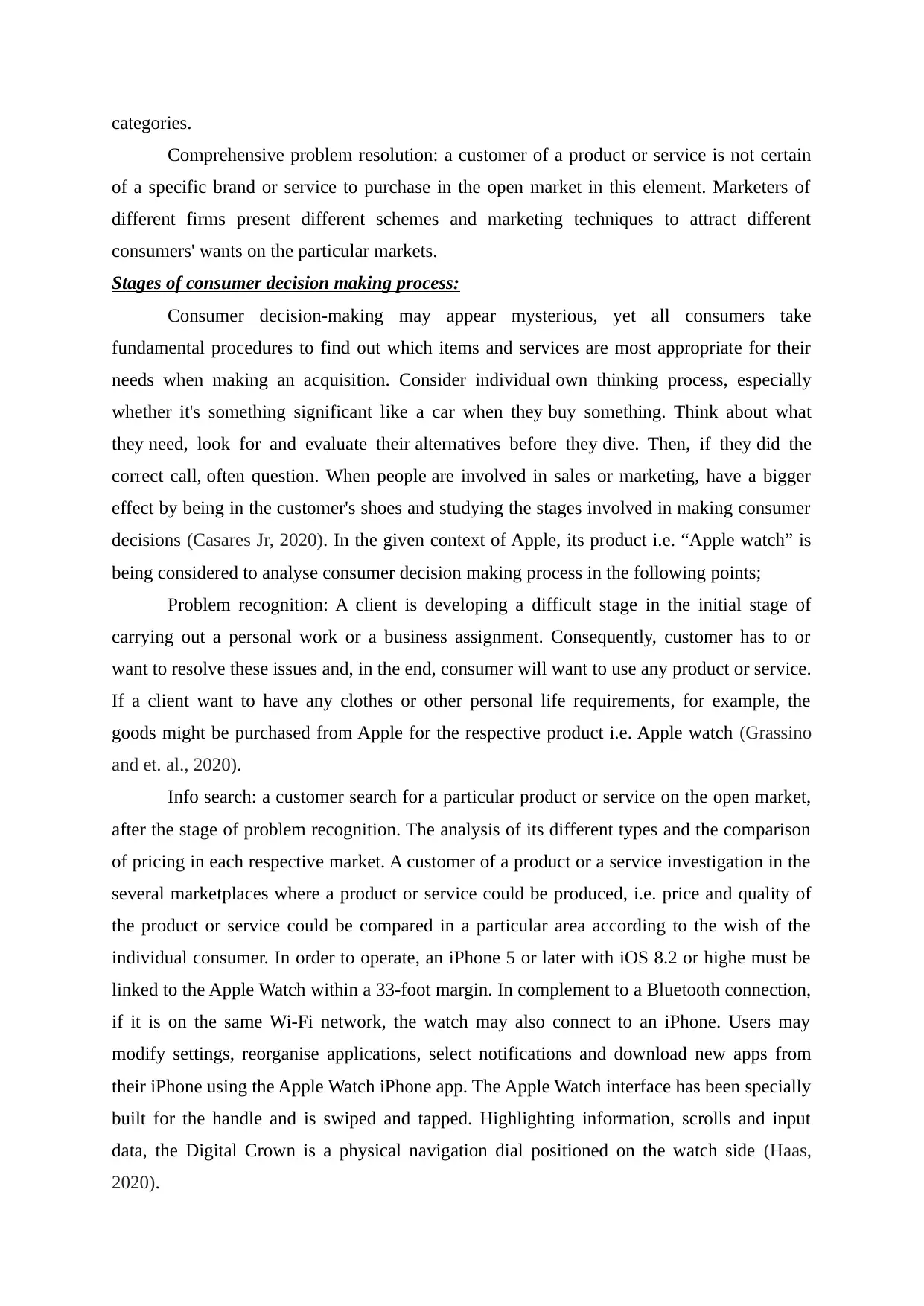
categories.
Comprehensive problem resolution: a customer of a product or service is not certain
of a specific brand or service to purchase in the open market in this element. Marketers of
different firms present different schemes and marketing techniques to attract different
consumers' wants on the particular markets.
Stages of consumer decision making process:
Consumer decision-making may appear mysterious, yet all consumers take
fundamental procedures to find out which items and services are most appropriate for their
needs when making an acquisition. Consider individual own thinking process, especially
whether it's something significant like a car when they buy something. Think about what
they need, look for and evaluate their alternatives before they dive. Then, if they did the
correct call, often question. When people are involved in sales or marketing, have a bigger
effect by being in the customer's shoes and studying the stages involved in making consumer
decisions (Casares Jr, 2020). In the given context of Apple, its product i.e. “Apple watch” is
being considered to analyse consumer decision making process in the following points;
Problem recognition: A client is developing a difficult stage in the initial stage of
carrying out a personal work or a business assignment. Consequently, customer has to or
want to resolve these issues and, in the end, consumer will want to use any product or service.
If a client want to have any clothes or other personal life requirements, for example, the
goods might be purchased from Apple for the respective product i.e. Apple watch (Grassino
and et. al., 2020).
Info search: a customer search for a particular product or service on the open market,
after the stage of problem recognition. The analysis of its different types and the comparison
of pricing in each respective market. A customer of a product or a service investigation in the
several marketplaces where a product or service could be produced, i.e. price and quality of
the product or service could be compared in a particular area according to the wish of the
individual consumer. In order to operate, an iPhone 5 or later with iOS 8.2 or highe must be
linked to the Apple Watch within a 33-foot margin. In complement to a Bluetooth connection,
if it is on the same Wi-Fi network, the watch may also connect to an iPhone. Users may
modify settings, reorganise applications, select notifications and download new apps from
their iPhone using the Apple Watch iPhone app. The Apple Watch interface has been specially
built for the handle and is swiped and tapped. Highlighting information, scrolls and input
data, the Digital Crown is a physical navigation dial positioned on the watch side (Haas,
2020).
Comprehensive problem resolution: a customer of a product or service is not certain
of a specific brand or service to purchase in the open market in this element. Marketers of
different firms present different schemes and marketing techniques to attract different
consumers' wants on the particular markets.
Stages of consumer decision making process:
Consumer decision-making may appear mysterious, yet all consumers take
fundamental procedures to find out which items and services are most appropriate for their
needs when making an acquisition. Consider individual own thinking process, especially
whether it's something significant like a car when they buy something. Think about what
they need, look for and evaluate their alternatives before they dive. Then, if they did the
correct call, often question. When people are involved in sales or marketing, have a bigger
effect by being in the customer's shoes and studying the stages involved in making consumer
decisions (Casares Jr, 2020). In the given context of Apple, its product i.e. “Apple watch” is
being considered to analyse consumer decision making process in the following points;
Problem recognition: A client is developing a difficult stage in the initial stage of
carrying out a personal work or a business assignment. Consequently, customer has to or
want to resolve these issues and, in the end, consumer will want to use any product or service.
If a client want to have any clothes or other personal life requirements, for example, the
goods might be purchased from Apple for the respective product i.e. Apple watch (Grassino
and et. al., 2020).
Info search: a customer search for a particular product or service on the open market,
after the stage of problem recognition. The analysis of its different types and the comparison
of pricing in each respective market. A customer of a product or a service investigation in the
several marketplaces where a product or service could be produced, i.e. price and quality of
the product or service could be compared in a particular area according to the wish of the
individual consumer. In order to operate, an iPhone 5 or later with iOS 8.2 or highe must be
linked to the Apple Watch within a 33-foot margin. In complement to a Bluetooth connection,
if it is on the same Wi-Fi network, the watch may also connect to an iPhone. Users may
modify settings, reorganise applications, select notifications and download new apps from
their iPhone using the Apple Watch iPhone app. The Apple Watch interface has been specially
built for the handle and is swiped and tapped. Highlighting information, scrolls and input
data, the Digital Crown is a physical navigation dial positioned on the watch side (Haas,
2020).
Paraphrase This Document
Need a fresh take? Get an instant paraphrase of this document with our AI Paraphraser
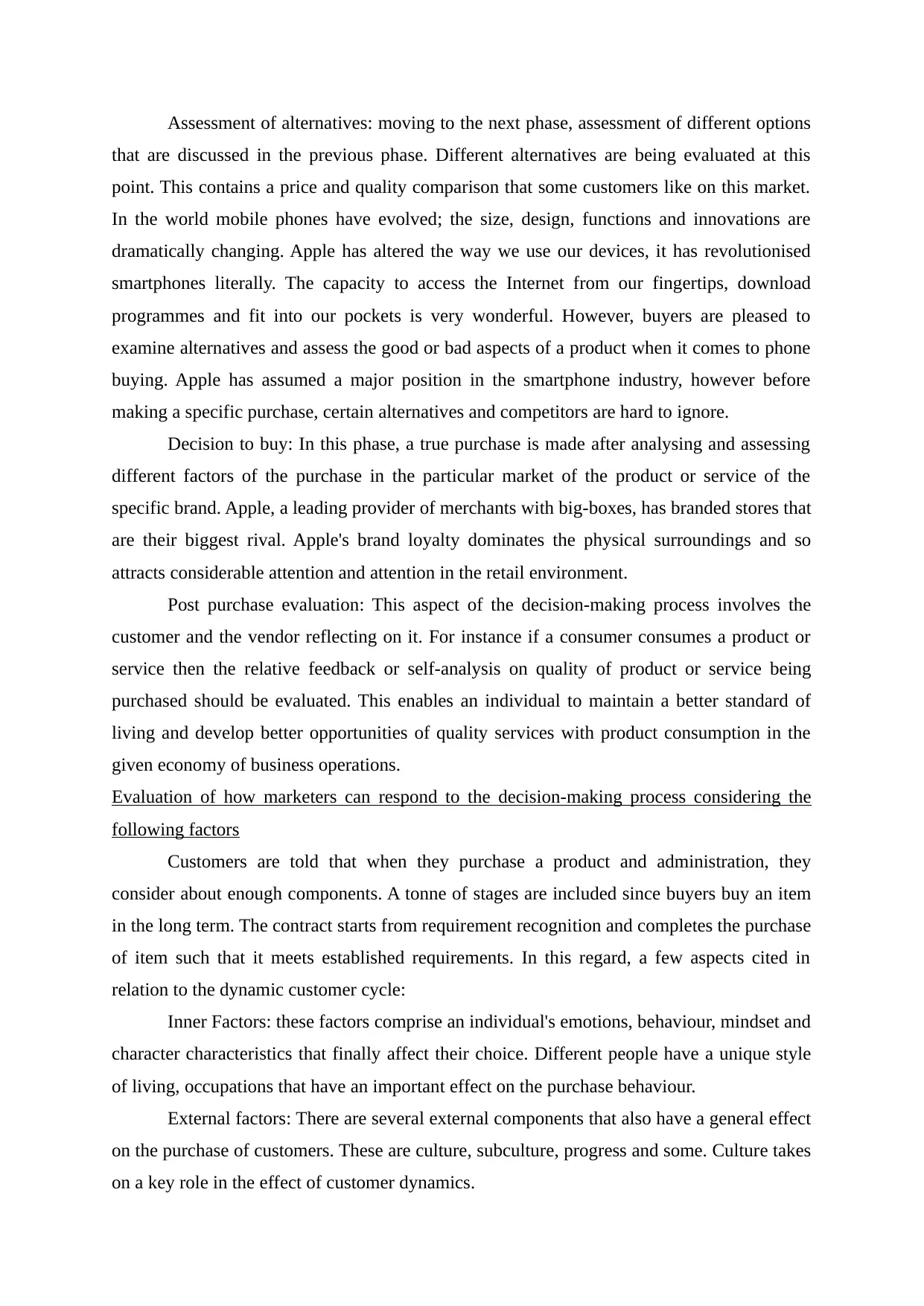
Assessment of alternatives: moving to the next phase, assessment of different options
that are discussed in the previous phase. Different alternatives are being evaluated at this
point. This contains a price and quality comparison that some customers like on this market.
In the world mobile phones have evolved; the size, design, functions and innovations are
dramatically changing. Apple has altered the way we use our devices, it has revolutionised
smartphones literally. The capacity to access the Internet from our fingertips, download
programmes and fit into our pockets is very wonderful. However, buyers are pleased to
examine alternatives and assess the good or bad aspects of a product when it comes to phone
buying. Apple has assumed a major position in the smartphone industry, however before
making a specific purchase, certain alternatives and competitors are hard to ignore.
Decision to buy: In this phase, a true purchase is made after analysing and assessing
different factors of the purchase in the particular market of the product or service of the
specific brand. Apple, a leading provider of merchants with big-boxes, has branded stores that
are their biggest rival. Apple's brand loyalty dominates the physical surroundings and so
attracts considerable attention and attention in the retail environment.
Post purchase evaluation: This aspect of the decision-making process involves the
customer and the vendor reflecting on it. For instance if a consumer consumes a product or
service then the relative feedback or self-analysis on quality of product or service being
purchased should be evaluated. This enables an individual to maintain a better standard of
living and develop better opportunities of quality services with product consumption in the
given economy of business operations.
Evaluation of how marketers can respond to the decision-making process considering the
following factors
Customers are told that when they purchase a product and administration, they
consider about enough components. A tonne of stages are included since buyers buy an item
in the long term. The contract starts from requirement recognition and completes the purchase
of item such that it meets established requirements. In this regard, a few aspects cited in
relation to the dynamic customer cycle:
Inner Factors: these factors comprise an individual's emotions, behaviour, mindset and
character characteristics that finally affect their choice. Different people have a unique style
of living, occupations that have an important effect on the purchase behaviour.
External factors: There are several external components that also have a general effect
on the purchase of customers. These are culture, subculture, progress and some. Culture takes
on a key role in the effect of customer dynamics.
that are discussed in the previous phase. Different alternatives are being evaluated at this
point. This contains a price and quality comparison that some customers like on this market.
In the world mobile phones have evolved; the size, design, functions and innovations are
dramatically changing. Apple has altered the way we use our devices, it has revolutionised
smartphones literally. The capacity to access the Internet from our fingertips, download
programmes and fit into our pockets is very wonderful. However, buyers are pleased to
examine alternatives and assess the good or bad aspects of a product when it comes to phone
buying. Apple has assumed a major position in the smartphone industry, however before
making a specific purchase, certain alternatives and competitors are hard to ignore.
Decision to buy: In this phase, a true purchase is made after analysing and assessing
different factors of the purchase in the particular market of the product or service of the
specific brand. Apple, a leading provider of merchants with big-boxes, has branded stores that
are their biggest rival. Apple's brand loyalty dominates the physical surroundings and so
attracts considerable attention and attention in the retail environment.
Post purchase evaluation: This aspect of the decision-making process involves the
customer and the vendor reflecting on it. For instance if a consumer consumes a product or
service then the relative feedback or self-analysis on quality of product or service being
purchased should be evaluated. This enables an individual to maintain a better standard of
living and develop better opportunities of quality services with product consumption in the
given economy of business operations.
Evaluation of how marketers can respond to the decision-making process considering the
following factors
Customers are told that when they purchase a product and administration, they
consider about enough components. A tonne of stages are included since buyers buy an item
in the long term. The contract starts from requirement recognition and completes the purchase
of item such that it meets established requirements. In this regard, a few aspects cited in
relation to the dynamic customer cycle:
Inner Factors: these factors comprise an individual's emotions, behaviour, mindset and
character characteristics that finally affect their choice. Different people have a unique style
of living, occupations that have an important effect on the purchase behaviour.
External factors: There are several external components that also have a general effect
on the purchase of customers. These are culture, subculture, progress and some. Culture takes
on a key role in the effect of customer dynamics.
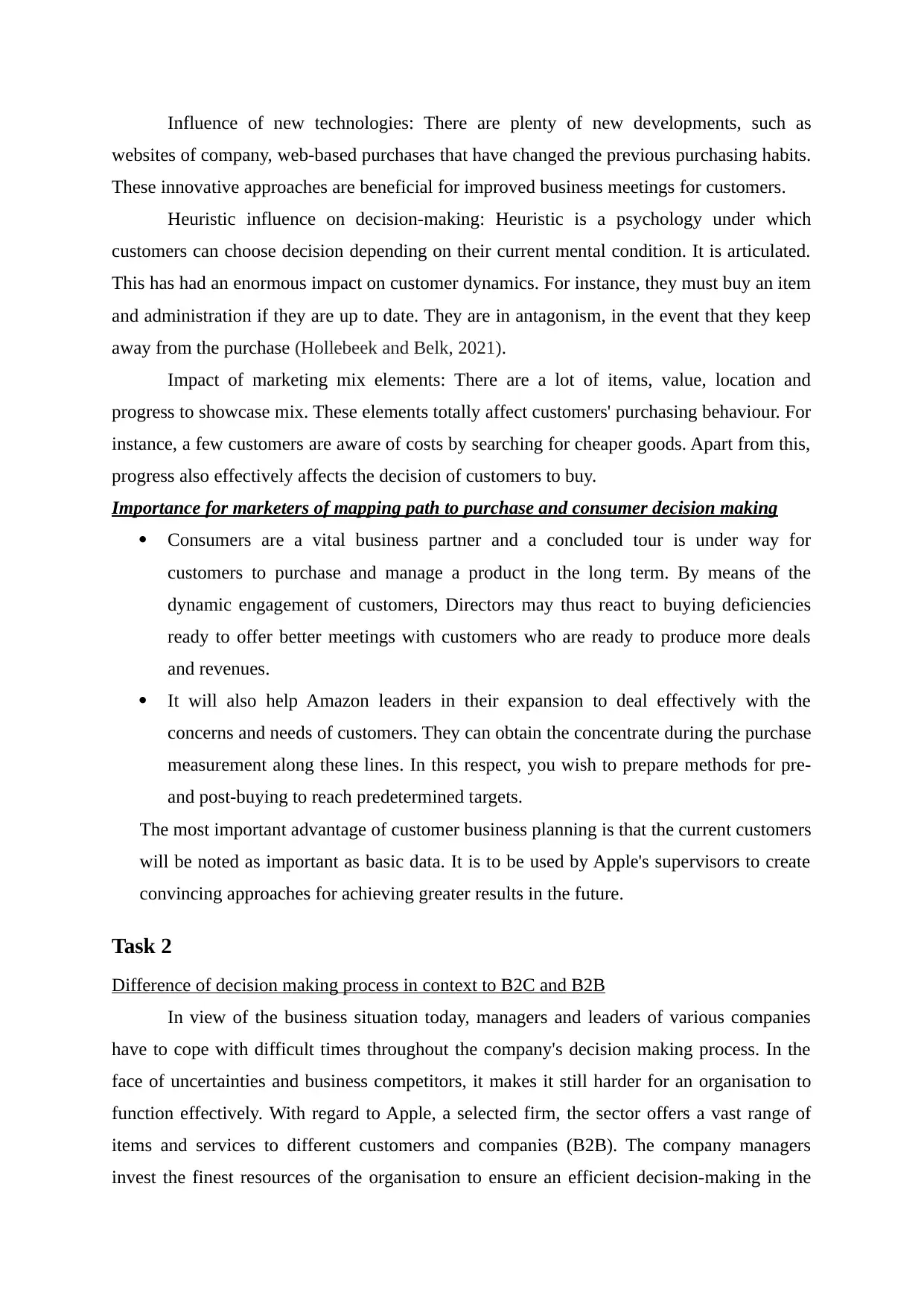
Influence of new technologies: There are plenty of new developments, such as
websites of company, web-based purchases that have changed the previous purchasing habits.
These innovative approaches are beneficial for improved business meetings for customers.
Heuristic influence on decision-making: Heuristic is a psychology under which
customers can choose decision depending on their current mental condition. It is articulated.
This has had an enormous impact on customer dynamics. For instance, they must buy an item
and administration if they are up to date. They are in antagonism, in the event that they keep
away from the purchase (Hollebeek and Belk, 2021).
Impact of marketing mix elements: There are a lot of items, value, location and
progress to showcase mix. These elements totally affect customers' purchasing behaviour. For
instance, a few customers are aware of costs by searching for cheaper goods. Apart from this,
progress also effectively affects the decision of customers to buy.
Importance for marketers of mapping path to purchase and consumer decision making
Consumers are a vital business partner and a concluded tour is under way for
customers to purchase and manage a product in the long term. By means of the
dynamic engagement of customers, Directors may thus react to buying deficiencies
ready to offer better meetings with customers who are ready to produce more deals
and revenues.
It will also help Amazon leaders in their expansion to deal effectively with the
concerns and needs of customers. They can obtain the concentrate during the purchase
measurement along these lines. In this respect, you wish to prepare methods for pre-
and post-buying to reach predetermined targets.
The most important advantage of customer business planning is that the current customers
will be noted as important as basic data. It is to be used by Apple's supervisors to create
convincing approaches for achieving greater results in the future.
Task 2
Difference of decision making process in context to B2C and B2B
In view of the business situation today, managers and leaders of various companies
have to cope with difficult times throughout the company's decision making process. In the
face of uncertainties and business competitors, it makes it still harder for an organisation to
function effectively. With regard to Apple, a selected firm, the sector offers a vast range of
items and services to different customers and companies (B2B). The company managers
invest the finest resources of the organisation to ensure an efficient decision-making in the
websites of company, web-based purchases that have changed the previous purchasing habits.
These innovative approaches are beneficial for improved business meetings for customers.
Heuristic influence on decision-making: Heuristic is a psychology under which
customers can choose decision depending on their current mental condition. It is articulated.
This has had an enormous impact on customer dynamics. For instance, they must buy an item
and administration if they are up to date. They are in antagonism, in the event that they keep
away from the purchase (Hollebeek and Belk, 2021).
Impact of marketing mix elements: There are a lot of items, value, location and
progress to showcase mix. These elements totally affect customers' purchasing behaviour. For
instance, a few customers are aware of costs by searching for cheaper goods. Apart from this,
progress also effectively affects the decision of customers to buy.
Importance for marketers of mapping path to purchase and consumer decision making
Consumers are a vital business partner and a concluded tour is under way for
customers to purchase and manage a product in the long term. By means of the
dynamic engagement of customers, Directors may thus react to buying deficiencies
ready to offer better meetings with customers who are ready to produce more deals
and revenues.
It will also help Amazon leaders in their expansion to deal effectively with the
concerns and needs of customers. They can obtain the concentrate during the purchase
measurement along these lines. In this respect, you wish to prepare methods for pre-
and post-buying to reach predetermined targets.
The most important advantage of customer business planning is that the current customers
will be noted as important as basic data. It is to be used by Apple's supervisors to create
convincing approaches for achieving greater results in the future.
Task 2
Difference of decision making process in context to B2C and B2B
In view of the business situation today, managers and leaders of various companies
have to cope with difficult times throughout the company's decision making process. In the
face of uncertainties and business competitors, it makes it still harder for an organisation to
function effectively. With regard to Apple, a selected firm, the sector offers a vast range of
items and services to different customers and companies (B2B). The company managers
invest the finest resources of the organisation to ensure an efficient decision-making in the
⊘ This is a preview!⊘
Do you want full access?
Subscribe today to unlock all pages.

Trusted by 1+ million students worldwide
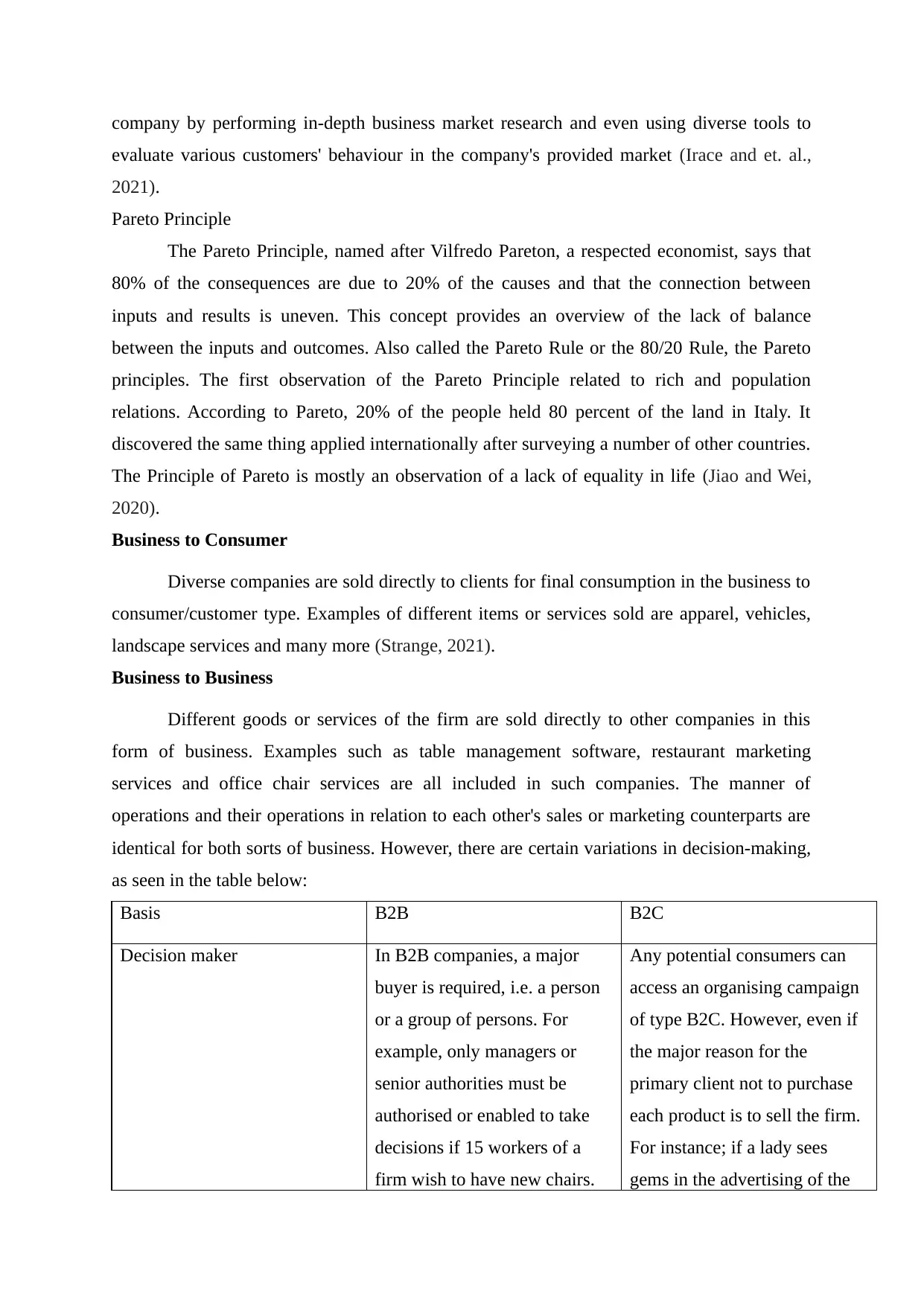
company by performing in-depth business market research and even using diverse tools to
evaluate various customers' behaviour in the company's provided market (Irace and et. al.,
2021).
Pareto Principle
The Pareto Principle, named after Vilfredo Pareton, a respected economist, says that
80% of the consequences are due to 20% of the causes and that the connection between
inputs and results is uneven. This concept provides an overview of the lack of balance
between the inputs and outcomes. Also called the Pareto Rule or the 80/20 Rule, the Pareto
principles. The first observation of the Pareto Principle related to rich and population
relations. According to Pareto, 20% of the people held 80 percent of the land in Italy. It
discovered the same thing applied internationally after surveying a number of other countries.
The Principle of Pareto is mostly an observation of a lack of equality in life (Jiao and Wei,
2020).
Business to Consumer
Diverse companies are sold directly to clients for final consumption in the business to
consumer/customer type. Examples of different items or services sold are apparel, vehicles,
landscape services and many more (Strange, 2021).
Business to Business
Different goods or services of the firm are sold directly to other companies in this
form of business. Examples such as table management software, restaurant marketing
services and office chair services are all included in such companies. The manner of
operations and their operations in relation to each other's sales or marketing counterparts are
identical for both sorts of business. However, there are certain variations in decision-making,
as seen in the table below:
Basis B2B B2C
Decision maker In B2B companies, a major
buyer is required, i.e. a person
or a group of persons. For
example, only managers or
senior authorities must be
authorised or enabled to take
decisions if 15 workers of a
firm wish to have new chairs.
Any potential consumers can
access an organising campaign
of type B2C. However, even if
the major reason for the
primary client not to purchase
each product is to sell the firm.
For instance; if a lady sees
gems in the advertising of the
evaluate various customers' behaviour in the company's provided market (Irace and et. al.,
2021).
Pareto Principle
The Pareto Principle, named after Vilfredo Pareton, a respected economist, says that
80% of the consequences are due to 20% of the causes and that the connection between
inputs and results is uneven. This concept provides an overview of the lack of balance
between the inputs and outcomes. Also called the Pareto Rule or the 80/20 Rule, the Pareto
principles. The first observation of the Pareto Principle related to rich and population
relations. According to Pareto, 20% of the people held 80 percent of the land in Italy. It
discovered the same thing applied internationally after surveying a number of other countries.
The Principle of Pareto is mostly an observation of a lack of equality in life (Jiao and Wei,
2020).
Business to Consumer
Diverse companies are sold directly to clients for final consumption in the business to
consumer/customer type. Examples of different items or services sold are apparel, vehicles,
landscape services and many more (Strange, 2021).
Business to Business
Different goods or services of the firm are sold directly to other companies in this
form of business. Examples such as table management software, restaurant marketing
services and office chair services are all included in such companies. The manner of
operations and their operations in relation to each other's sales or marketing counterparts are
identical for both sorts of business. However, there are certain variations in decision-making,
as seen in the table below:
Basis B2B B2C
Decision maker In B2B companies, a major
buyer is required, i.e. a person
or a group of persons. For
example, only managers or
senior authorities must be
authorised or enabled to take
decisions if 15 workers of a
firm wish to have new chairs.
Any potential consumers can
access an organising campaign
of type B2C. However, even if
the major reason for the
primary client not to purchase
each product is to sell the firm.
For instance; if a lady sees
gems in the advertising of the
Paraphrase This Document
Need a fresh take? Get an instant paraphrase of this document with our AI Paraphraser
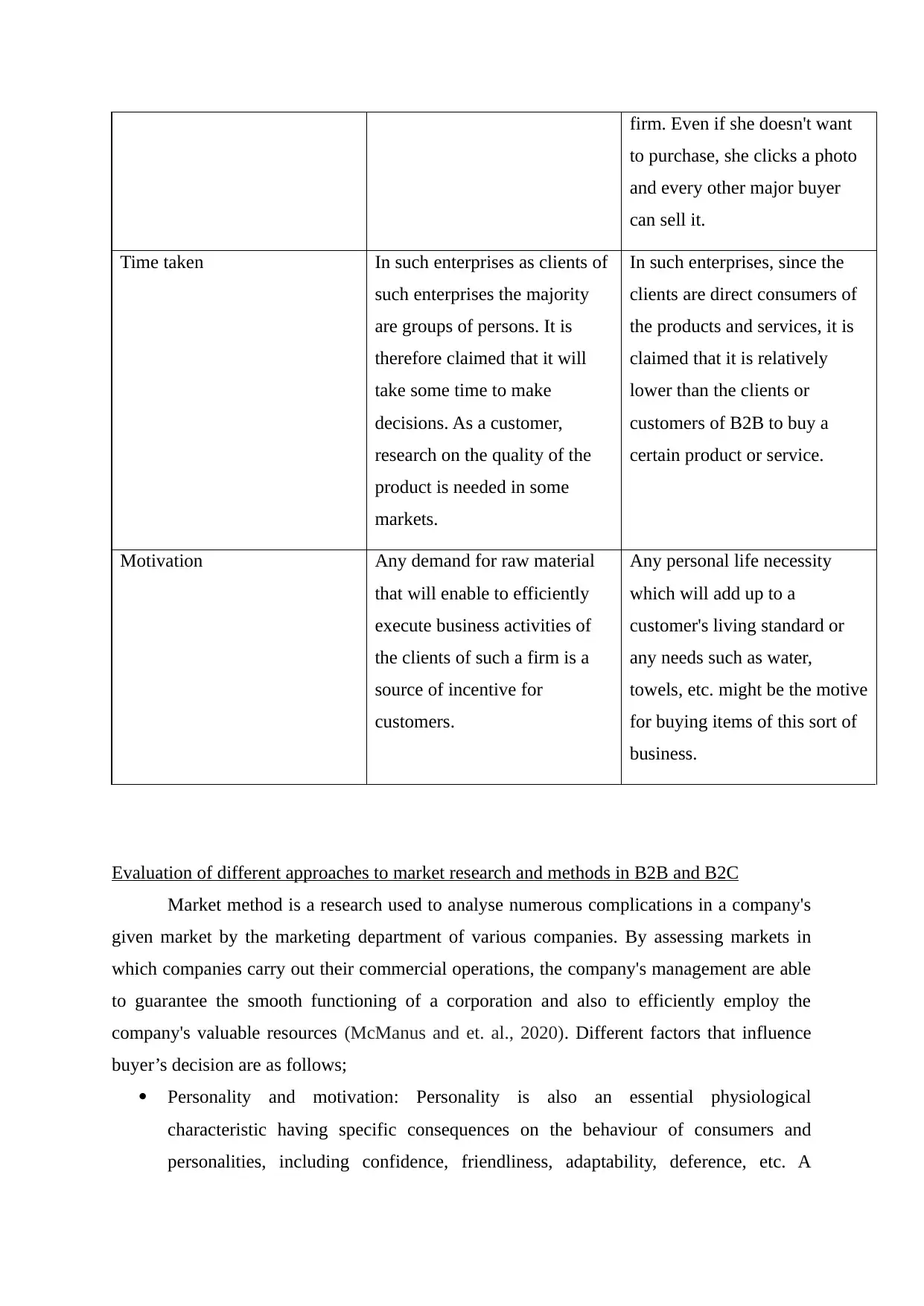
firm. Even if she doesn't want
to purchase, she clicks a photo
and every other major buyer
can sell it.
Time taken In such enterprises as clients of
such enterprises the majority
are groups of persons. It is
therefore claimed that it will
take some time to make
decisions. As a customer,
research on the quality of the
product is needed in some
markets.
In such enterprises, since the
clients are direct consumers of
the products and services, it is
claimed that it is relatively
lower than the clients or
customers of B2B to buy a
certain product or service.
Motivation Any demand for raw material
that will enable to efficiently
execute business activities of
the clients of such a firm is a
source of incentive for
customers.
Any personal life necessity
which will add up to a
customer's living standard or
any needs such as water,
towels, etc. might be the motive
for buying items of this sort of
business.
Evaluation of different approaches to market research and methods in B2B and B2C
Market method is a research used to analyse numerous complications in a company's
given market by the marketing department of various companies. By assessing markets in
which companies carry out their commercial operations, the company's management are able
to guarantee the smooth functioning of a corporation and also to efficiently employ the
company's valuable resources (McManus and et. al., 2020). Different factors that influence
buyer’s decision are as follows;
Personality and motivation: Personality is also an essential physiological
characteristic having specific consequences on the behaviour of consumers and
personalities, including confidence, friendliness, adaptability, deference, etc. A
to purchase, she clicks a photo
and every other major buyer
can sell it.
Time taken In such enterprises as clients of
such enterprises the majority
are groups of persons. It is
therefore claimed that it will
take some time to make
decisions. As a customer,
research on the quality of the
product is needed in some
markets.
In such enterprises, since the
clients are direct consumers of
the products and services, it is
claimed that it is relatively
lower than the clients or
customers of B2B to buy a
certain product or service.
Motivation Any demand for raw material
that will enable to efficiently
execute business activities of
the clients of such a firm is a
source of incentive for
customers.
Any personal life necessity
which will add up to a
customer's living standard or
any needs such as water,
towels, etc. might be the motive
for buying items of this sort of
business.
Evaluation of different approaches to market research and methods in B2B and B2C
Market method is a research used to analyse numerous complications in a company's
given market by the marketing department of various companies. By assessing markets in
which companies carry out their commercial operations, the company's management are able
to guarantee the smooth functioning of a corporation and also to efficiently employ the
company's valuable resources (McManus and et. al., 2020). Different factors that influence
buyer’s decision are as follows;
Personality and motivation: Personality is also an essential physiological
characteristic having specific consequences on the behaviour of consumers and
personalities, including confidence, friendliness, adaptability, deference, etc. A
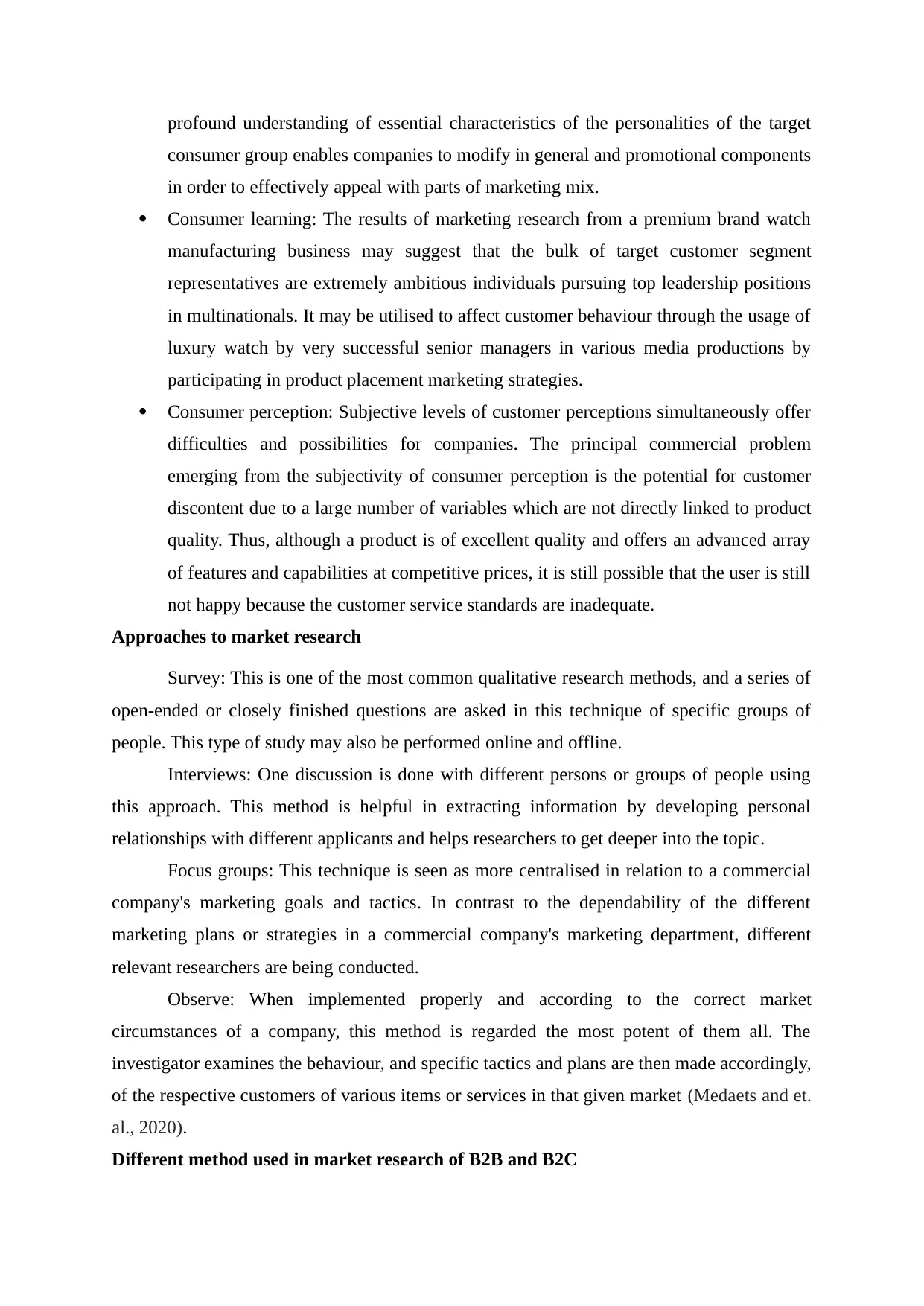
profound understanding of essential characteristics of the personalities of the target
consumer group enables companies to modify in general and promotional components
in order to effectively appeal with parts of marketing mix.
Consumer learning: The results of marketing research from a premium brand watch
manufacturing business may suggest that the bulk of target customer segment
representatives are extremely ambitious individuals pursuing top leadership positions
in multinationals. It may be utilised to affect customer behaviour through the usage of
luxury watch by very successful senior managers in various media productions by
participating in product placement marketing strategies.
Consumer perception: Subjective levels of customer perceptions simultaneously offer
difficulties and possibilities for companies. The principal commercial problem
emerging from the subjectivity of consumer perception is the potential for customer
discontent due to a large number of variables which are not directly linked to product
quality. Thus, although a product is of excellent quality and offers an advanced array
of features and capabilities at competitive prices, it is still possible that the user is still
not happy because the customer service standards are inadequate.
Approaches to market research
Survey: This is one of the most common qualitative research methods, and a series of
open-ended or closely finished questions are asked in this technique of specific groups of
people. This type of study may also be performed online and offline.
Interviews: One discussion is done with different persons or groups of people using
this approach. This method is helpful in extracting information by developing personal
relationships with different applicants and helps researchers to get deeper into the topic.
Focus groups: This technique is seen as more centralised in relation to a commercial
company's marketing goals and tactics. In contrast to the dependability of the different
marketing plans or strategies in a commercial company's marketing department, different
relevant researchers are being conducted.
Observe: When implemented properly and according to the correct market
circumstances of a company, this method is regarded the most potent of them all. The
investigator examines the behaviour, and specific tactics and plans are then made accordingly,
of the respective customers of various items or services in that given market (Medaets and et.
al., 2020).
Different method used in market research of B2B and B2C
consumer group enables companies to modify in general and promotional components
in order to effectively appeal with parts of marketing mix.
Consumer learning: The results of marketing research from a premium brand watch
manufacturing business may suggest that the bulk of target customer segment
representatives are extremely ambitious individuals pursuing top leadership positions
in multinationals. It may be utilised to affect customer behaviour through the usage of
luxury watch by very successful senior managers in various media productions by
participating in product placement marketing strategies.
Consumer perception: Subjective levels of customer perceptions simultaneously offer
difficulties and possibilities for companies. The principal commercial problem
emerging from the subjectivity of consumer perception is the potential for customer
discontent due to a large number of variables which are not directly linked to product
quality. Thus, although a product is of excellent quality and offers an advanced array
of features and capabilities at competitive prices, it is still possible that the user is still
not happy because the customer service standards are inadequate.
Approaches to market research
Survey: This is one of the most common qualitative research methods, and a series of
open-ended or closely finished questions are asked in this technique of specific groups of
people. This type of study may also be performed online and offline.
Interviews: One discussion is done with different persons or groups of people using
this approach. This method is helpful in extracting information by developing personal
relationships with different applicants and helps researchers to get deeper into the topic.
Focus groups: This technique is seen as more centralised in relation to a commercial
company's marketing goals and tactics. In contrast to the dependability of the different
marketing plans or strategies in a commercial company's marketing department, different
relevant researchers are being conducted.
Observe: When implemented properly and according to the correct market
circumstances of a company, this method is regarded the most potent of them all. The
investigator examines the behaviour, and specific tactics and plans are then made accordingly,
of the respective customers of various items or services in that given market (Medaets and et.
al., 2020).
Different method used in market research of B2B and B2C
⊘ This is a preview!⊘
Do you want full access?
Subscribe today to unlock all pages.

Trusted by 1+ million students worldwide
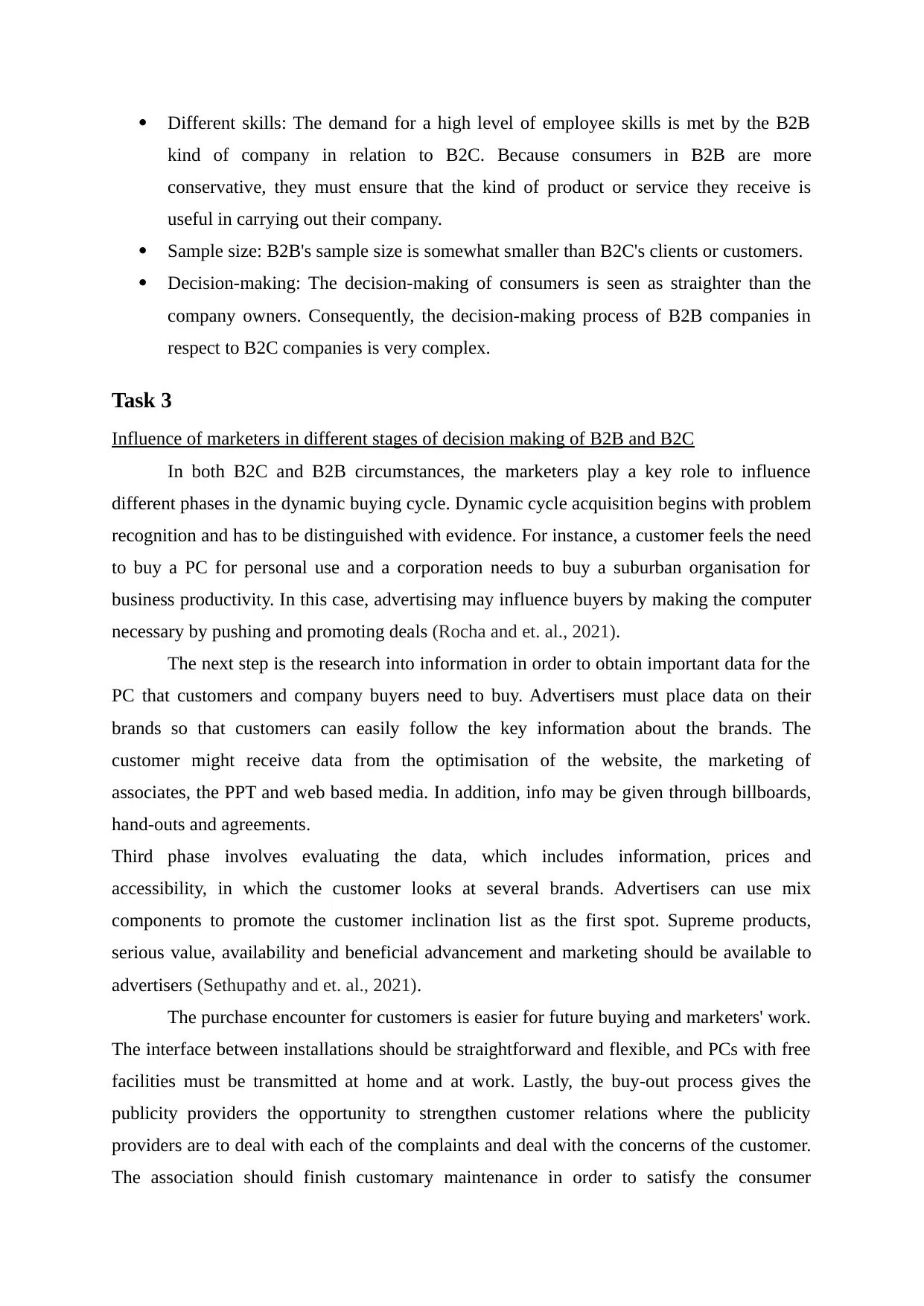
Different skills: The demand for a high level of employee skills is met by the B2B
kind of company in relation to B2C. Because consumers in B2B are more
conservative, they must ensure that the kind of product or service they receive is
useful in carrying out their company.
Sample size: B2B's sample size is somewhat smaller than B2C's clients or customers.
Decision-making: The decision-making of consumers is seen as straighter than the
company owners. Consequently, the decision-making process of B2B companies in
respect to B2C companies is very complex.
Task 3
Influence of marketers in different stages of decision making of B2B and B2C
In both B2C and B2B circumstances, the marketers play a key role to influence
different phases in the dynamic buying cycle. Dynamic cycle acquisition begins with problem
recognition and has to be distinguished with evidence. For instance, a customer feels the need
to buy a PC for personal use and a corporation needs to buy a suburban organisation for
business productivity. In this case, advertising may influence buyers by making the computer
necessary by pushing and promoting deals (Rocha and et. al., 2021).
The next step is the research into information in order to obtain important data for the
PC that customers and company buyers need to buy. Advertisers must place data on their
brands so that customers can easily follow the key information about the brands. The
customer might receive data from the optimisation of the website, the marketing of
associates, the PPT and web based media. In addition, info may be given through billboards,
hand-outs and agreements.
Third phase involves evaluating the data, which includes information, prices and
accessibility, in which the customer looks at several brands. Advertisers can use mix
components to promote the customer inclination list as the first spot. Supreme products,
serious value, availability and beneficial advancement and marketing should be available to
advertisers (Sethupathy and et. al., 2021).
The purchase encounter for customers is easier for future buying and marketers' work.
The interface between installations should be straightforward and flexible, and PCs with free
facilities must be transmitted at home and at work. Lastly, the buy-out process gives the
publicity providers the opportunity to strengthen customer relations where the publicity
providers are to deal with each of the complaints and deal with the concerns of the customer.
The association should finish customary maintenance in order to satisfy the consumer
kind of company in relation to B2C. Because consumers in B2B are more
conservative, they must ensure that the kind of product or service they receive is
useful in carrying out their company.
Sample size: B2B's sample size is somewhat smaller than B2C's clients or customers.
Decision-making: The decision-making of consumers is seen as straighter than the
company owners. Consequently, the decision-making process of B2B companies in
respect to B2C companies is very complex.
Task 3
Influence of marketers in different stages of decision making of B2B and B2C
In both B2C and B2B circumstances, the marketers play a key role to influence
different phases in the dynamic buying cycle. Dynamic cycle acquisition begins with problem
recognition and has to be distinguished with evidence. For instance, a customer feels the need
to buy a PC for personal use and a corporation needs to buy a suburban organisation for
business productivity. In this case, advertising may influence buyers by making the computer
necessary by pushing and promoting deals (Rocha and et. al., 2021).
The next step is the research into information in order to obtain important data for the
PC that customers and company buyers need to buy. Advertisers must place data on their
brands so that customers can easily follow the key information about the brands. The
customer might receive data from the optimisation of the website, the marketing of
associates, the PPT and web based media. In addition, info may be given through billboards,
hand-outs and agreements.
Third phase involves evaluating the data, which includes information, prices and
accessibility, in which the customer looks at several brands. Advertisers can use mix
components to promote the customer inclination list as the first spot. Supreme products,
serious value, availability and beneficial advancement and marketing should be available to
advertisers (Sethupathy and et. al., 2021).
The purchase encounter for customers is easier for future buying and marketers' work.
The interface between installations should be straightforward and flexible, and PCs with free
facilities must be transmitted at home and at work. Lastly, the buy-out process gives the
publicity providers the opportunity to strengthen customer relations where the publicity
providers are to deal with each of the complaints and deal with the concerns of the customer.
The association should finish customary maintenance in order to satisfy the consumer
Paraphrase This Document
Need a fresh take? Get an instant paraphrase of this document with our AI Paraphraser
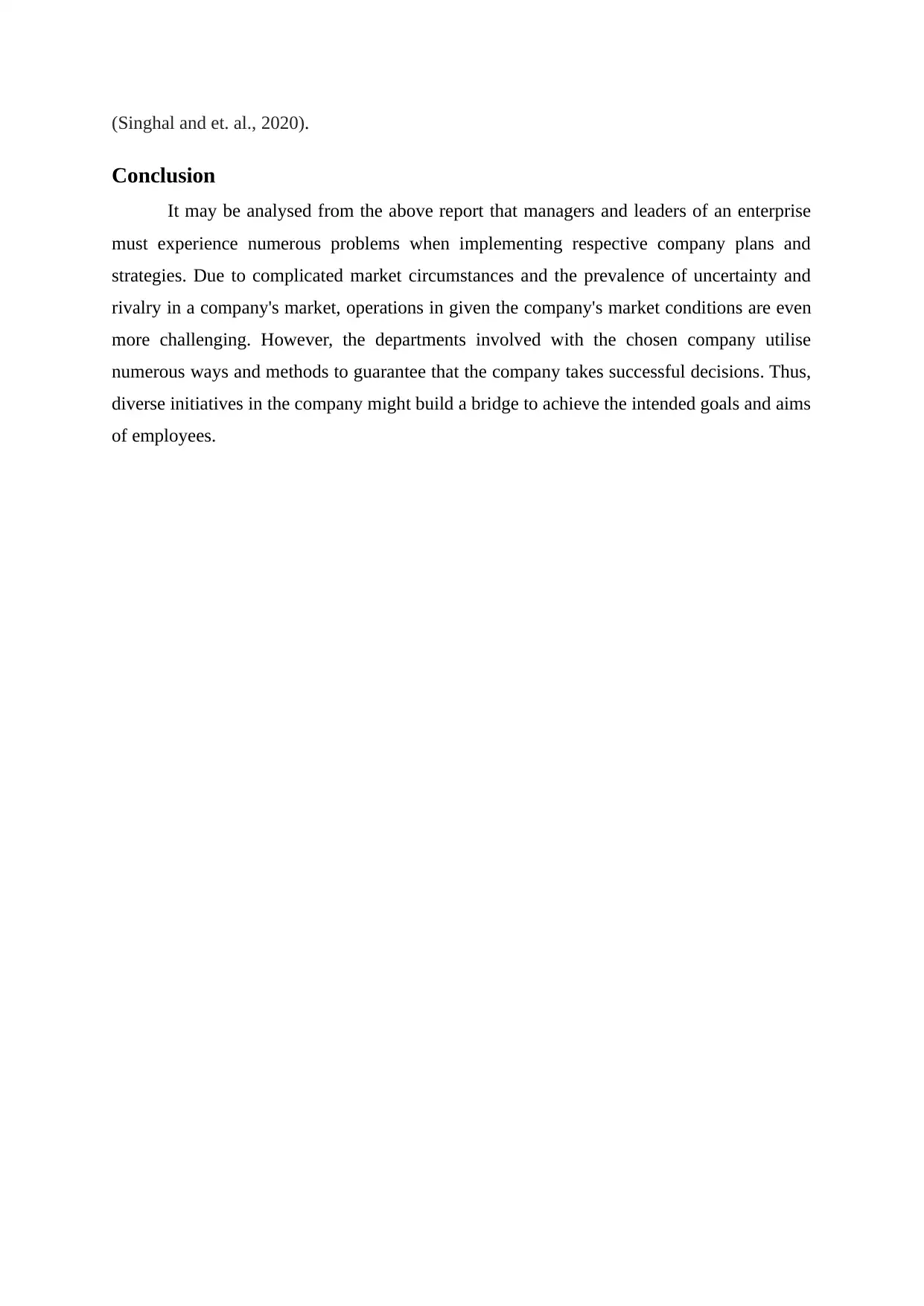
(Singhal and et. al., 2020).
Conclusion
It may be analysed from the above report that managers and leaders of an enterprise
must experience numerous problems when implementing respective company plans and
strategies. Due to complicated market circumstances and the prevalence of uncertainty and
rivalry in a company's market, operations in given the company's market conditions are even
more challenging. However, the departments involved with the chosen company utilise
numerous ways and methods to guarantee that the company takes successful decisions. Thus,
diverse initiatives in the company might build a bridge to achieve the intended goals and aims
of employees.
Conclusion
It may be analysed from the above report that managers and leaders of an enterprise
must experience numerous problems when implementing respective company plans and
strategies. Due to complicated market circumstances and the prevalence of uncertainty and
rivalry in a company's market, operations in given the company's market conditions are even
more challenging. However, the departments involved with the chosen company utilise
numerous ways and methods to guarantee that the company takes successful decisions. Thus,
diverse initiatives in the company might build a bridge to achieve the intended goals and aims
of employees.
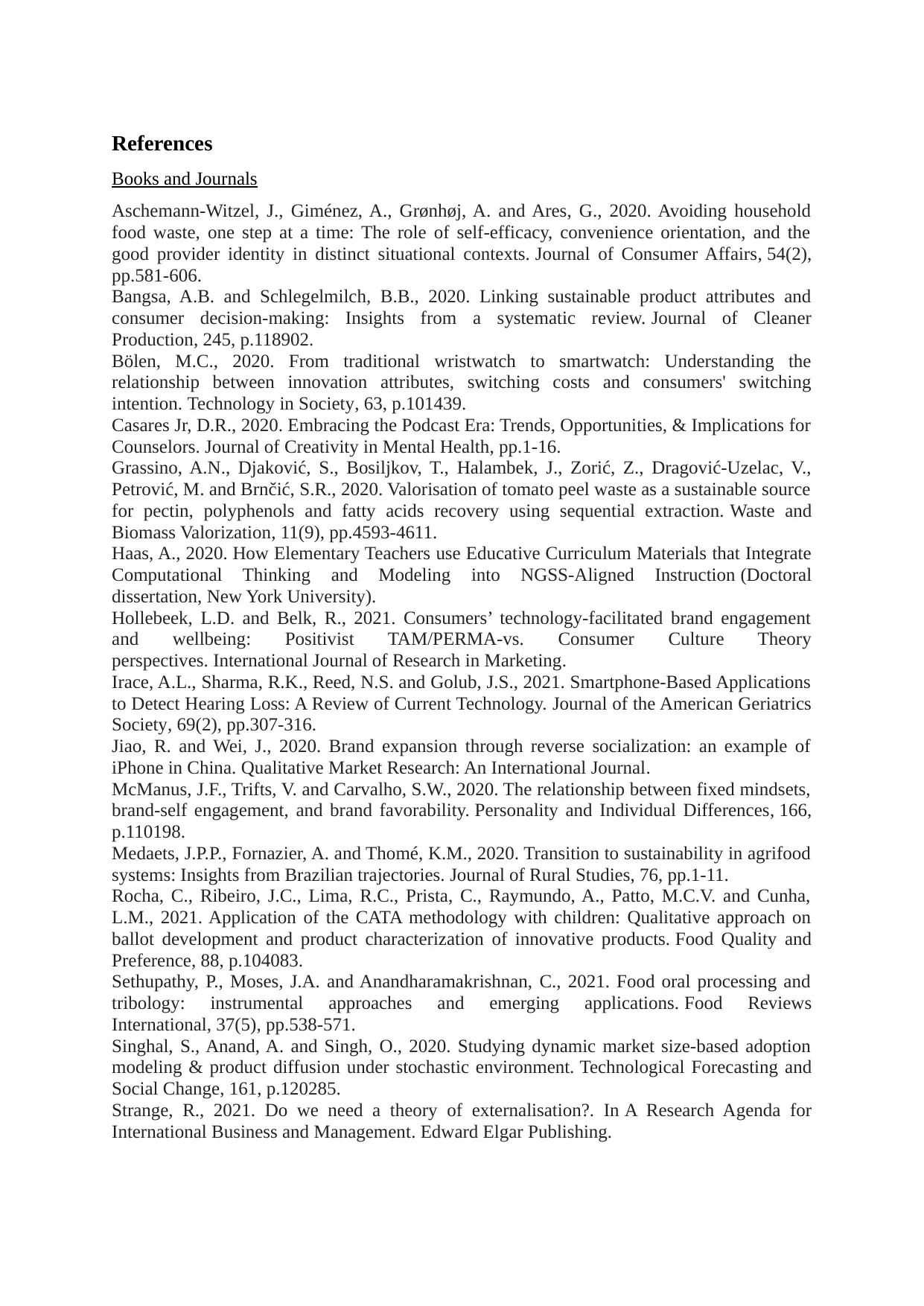
References
Books and Journals
Aschemann‐Witzel, J., Giménez, A., Grønhøj, A. and Ares, G., 2020. Avoiding household
food waste, one step at a time: The role of self‐efficacy, convenience orientation, and the
good provider identity in distinct situational contexts. Journal of Consumer Affairs, 54(2),
pp.581-606.
Bangsa, A.B. and Schlegelmilch, B.B., 2020. Linking sustainable product attributes and
consumer decision-making: Insights from a systematic review. Journal of Cleaner
Production, 245, p.118902.
Bölen, M.C., 2020. From traditional wristwatch to smartwatch: Understanding the
relationship between innovation attributes, switching costs and consumers' switching
intention. Technology in Society, 63, p.101439.
Casares Jr, D.R., 2020. Embracing the Podcast Era: Trends, Opportunities, & Implications for
Counselors. Journal of Creativity in Mental Health, pp.1-16.
Grassino, A.N., Djaković, S., Bosiljkov, T., Halambek, J., Zorić, Z., Dragović-Uzelac, V.,
Petrović, M. and Brnčić, S.R., 2020. Valorisation of tomato peel waste as a sustainable source
for pectin, polyphenols and fatty acids recovery using sequential extraction. Waste and
Biomass Valorization, 11(9), pp.4593-4611.
Haas, A., 2020. How Elementary Teachers use Educative Curriculum Materials that Integrate
Computational Thinking and Modeling into NGSS-Aligned Instruction (Doctoral
dissertation, New York University).
Hollebeek, L.D. and Belk, R., 2021. Consumers’ technology-facilitated brand engagement
and wellbeing: Positivist TAM/PERMA-vs. Consumer Culture Theory
perspectives. International Journal of Research in Marketing.
Irace, A.L., Sharma, R.K., Reed, N.S. and Golub, J.S., 2021. Smartphone‐Based Applications
to Detect Hearing Loss: A Review of Current Technology. Journal of the American Geriatrics
Society, 69(2), pp.307-316.
Jiao, R. and Wei, J., 2020. Brand expansion through reverse socialization: an example of
iPhone in China. Qualitative Market Research: An International Journal.
McManus, J.F., Trifts, V. and Carvalho, S.W., 2020. The relationship between fixed mindsets,
brand-self engagement, and brand favorability. Personality and Individual Differences, 166,
p.110198.
Medaets, J.P.P., Fornazier, A. and Thomé, K.M., 2020. Transition to sustainability in agrifood
systems: Insights from Brazilian trajectories. Journal of Rural Studies, 76, pp.1-11.
Rocha, C., Ribeiro, J.C., Lima, R.C., Prista, C., Raymundo, A., Patto, M.C.V. and Cunha,
L.M., 2021. Application of the CATA methodology with children: Qualitative approach on
ballot development and product characterization of innovative products. Food Quality and
Preference, 88, p.104083.
Sethupathy, P., Moses, J.A. and Anandharamakrishnan, C., 2021. Food oral processing and
tribology: instrumental approaches and emerging applications. Food Reviews
International, 37(5), pp.538-571.
Singhal, S., Anand, A. and Singh, O., 2020. Studying dynamic market size-based adoption
modeling & product diffusion under stochastic environment. Technological Forecasting and
Social Change, 161, p.120285.
Strange, R., 2021. Do we need a theory of externalisation?. In A Research Agenda for
International Business and Management. Edward Elgar Publishing.
Books and Journals
Aschemann‐Witzel, J., Giménez, A., Grønhøj, A. and Ares, G., 2020. Avoiding household
food waste, one step at a time: The role of self‐efficacy, convenience orientation, and the
good provider identity in distinct situational contexts. Journal of Consumer Affairs, 54(2),
pp.581-606.
Bangsa, A.B. and Schlegelmilch, B.B., 2020. Linking sustainable product attributes and
consumer decision-making: Insights from a systematic review. Journal of Cleaner
Production, 245, p.118902.
Bölen, M.C., 2020. From traditional wristwatch to smartwatch: Understanding the
relationship between innovation attributes, switching costs and consumers' switching
intention. Technology in Society, 63, p.101439.
Casares Jr, D.R., 2020. Embracing the Podcast Era: Trends, Opportunities, & Implications for
Counselors. Journal of Creativity in Mental Health, pp.1-16.
Grassino, A.N., Djaković, S., Bosiljkov, T., Halambek, J., Zorić, Z., Dragović-Uzelac, V.,
Petrović, M. and Brnčić, S.R., 2020. Valorisation of tomato peel waste as a sustainable source
for pectin, polyphenols and fatty acids recovery using sequential extraction. Waste and
Biomass Valorization, 11(9), pp.4593-4611.
Haas, A., 2020. How Elementary Teachers use Educative Curriculum Materials that Integrate
Computational Thinking and Modeling into NGSS-Aligned Instruction (Doctoral
dissertation, New York University).
Hollebeek, L.D. and Belk, R., 2021. Consumers’ technology-facilitated brand engagement
and wellbeing: Positivist TAM/PERMA-vs. Consumer Culture Theory
perspectives. International Journal of Research in Marketing.
Irace, A.L., Sharma, R.K., Reed, N.S. and Golub, J.S., 2021. Smartphone‐Based Applications
to Detect Hearing Loss: A Review of Current Technology. Journal of the American Geriatrics
Society, 69(2), pp.307-316.
Jiao, R. and Wei, J., 2020. Brand expansion through reverse socialization: an example of
iPhone in China. Qualitative Market Research: An International Journal.
McManus, J.F., Trifts, V. and Carvalho, S.W., 2020. The relationship between fixed mindsets,
brand-self engagement, and brand favorability. Personality and Individual Differences, 166,
p.110198.
Medaets, J.P.P., Fornazier, A. and Thomé, K.M., 2020. Transition to sustainability in agrifood
systems: Insights from Brazilian trajectories. Journal of Rural Studies, 76, pp.1-11.
Rocha, C., Ribeiro, J.C., Lima, R.C., Prista, C., Raymundo, A., Patto, M.C.V. and Cunha,
L.M., 2021. Application of the CATA methodology with children: Qualitative approach on
ballot development and product characterization of innovative products. Food Quality and
Preference, 88, p.104083.
Sethupathy, P., Moses, J.A. and Anandharamakrishnan, C., 2021. Food oral processing and
tribology: instrumental approaches and emerging applications. Food Reviews
International, 37(5), pp.538-571.
Singhal, S., Anand, A. and Singh, O., 2020. Studying dynamic market size-based adoption
modeling & product diffusion under stochastic environment. Technological Forecasting and
Social Change, 161, p.120285.
Strange, R., 2021. Do we need a theory of externalisation?. In A Research Agenda for
International Business and Management. Edward Elgar Publishing.
⊘ This is a preview!⊘
Do you want full access?
Subscribe today to unlock all pages.

Trusted by 1+ million students worldwide
1 out of 13
Related Documents
Your All-in-One AI-Powered Toolkit for Academic Success.
+13062052269
info@desklib.com
Available 24*7 on WhatsApp / Email
![[object Object]](/_next/static/media/star-bottom.7253800d.svg)
Unlock your academic potential
Copyright © 2020–2025 A2Z Services. All Rights Reserved. Developed and managed by ZUCOL.





